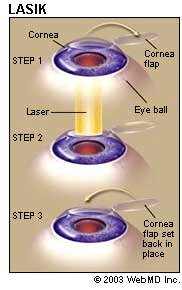Get the App
For Doctors
Login/Sign-up
Last Updated: Aug 29, 2019
BookMark
Report
LASIK, Laser - No Need for Spectacles or Contact Lenses !LASI
LASIK or Laser Vision Correction is a proven, highly successful procedure to give up spectacles or contact lenses.
Most types of eye sight problems, such as short sight (minus power) or long sight (plus power) can be corrected by these procedures.
The benefits are clear:
• First of all, It works! It corrects vision. Around 96% of patients will have their desired vision after LASIK. An enhancement, if at all needed, can further increase this number.
• LASIK is associated with very little pain due to the numbing drops that are used. The discomfort experienced hardly lasts few seconds.
• Vision is corrected nearly immediately or by the next day after LASIK.
• No bandages or stitches are required after LASIK.
• Adjustments can be made years after LASIK to further correct vision if vision changes while you age.
• After having LASIK, most patients have a dramatic reduction in eyeglass or contact lens dependence and many patients no longer need them at all.
The actual procedure:
Basically, Lasik or Laser Vision Correction can be done in different ways. The most commonly done procedure needs a thin flap to be taken from the cornea ( the curved glass like structure which makes the front of our eyes ). This flap making can be done by an automated, very thin, rotating blade (microkeratome) or by a very advanced Laser, called Femtosecond. The femtosecond laser option is the best, but also the most expensive, may not be suitable for all eyes. After creating the flap, the next most important part is the application of excimer laser, which is a must for all Laser Vision Correction procedures.
There are few side effects or complications, but most of them can be prevented by careful preoperative planning or can be overcome by treatment or eye drops after the procedure.
Most types of eye sight problems, such as short sight (minus power) or long sight (plus power) can be corrected by these procedures.
The benefits are clear:
• First of all, It works! It corrects vision. Around 96% of patients will have their desired vision after LASIK. An enhancement, if at all needed, can further increase this number.
• LASIK is associated with very little pain due to the numbing drops that are used. The discomfort experienced hardly lasts few seconds.
• Vision is corrected nearly immediately or by the next day after LASIK.
• No bandages or stitches are required after LASIK.
• Adjustments can be made years after LASIK to further correct vision if vision changes while you age.
• After having LASIK, most patients have a dramatic reduction in eyeglass or contact lens dependence and many patients no longer need them at all.
The actual procedure:
Basically, Lasik or Laser Vision Correction can be done in different ways. The most commonly done procedure needs a thin flap to be taken from the cornea ( the curved glass like structure which makes the front of our eyes ). This flap making can be done by an automated, very thin, rotating blade (microkeratome) or by a very advanced Laser, called Femtosecond. The femtosecond laser option is the best, but also the most expensive, may not be suitable for all eyes. After creating the flap, the next most important part is the application of excimer laser, which is a must for all Laser Vision Correction procedures.
There are few side effects or complications, but most of them can be prevented by careful preoperative planning or can be overcome by treatment or eye drops after the procedure.



+1.svg)
